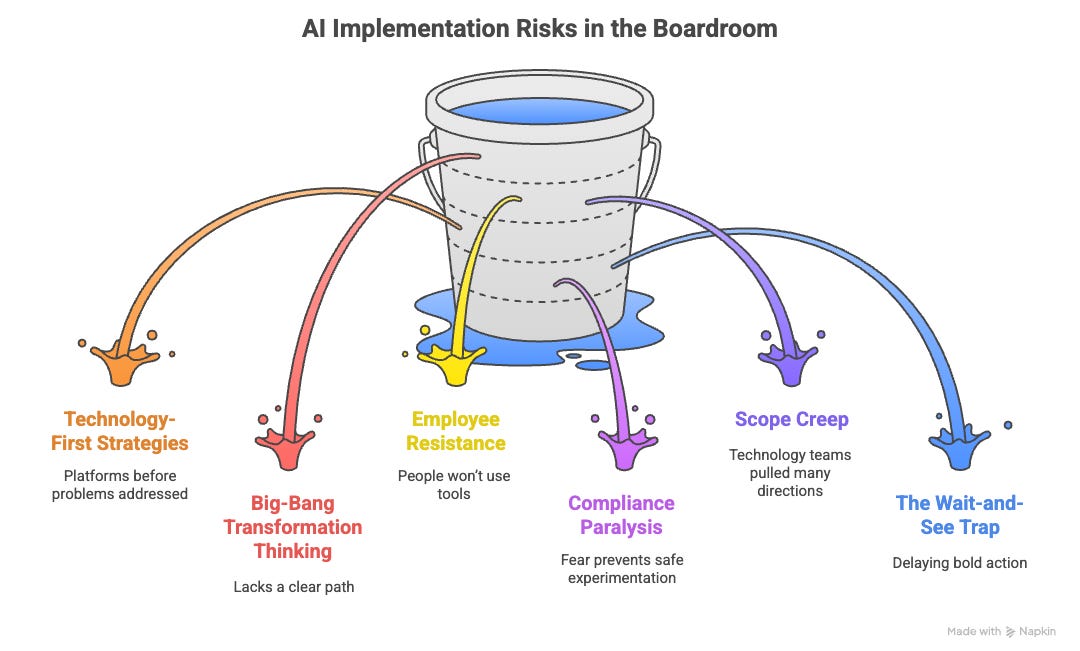Why 92% of AI Investments Fail (And How to Be the 8%)
Learn how mission-driven leaders can cut through the noise and make strategic decisions that create real value.
Thanks for reading! To access our community, full prompt library, coaching, and AI tools saving leaders 5-10 hours per week, check out our Premium Hub.
Have you ever watched a leader throw money at a problem, hoping volume will compensate for strategy?
I’ve watched this play out more times than I can count. The setting changes, but the story stays the same.
A senior leader stands up in a boardroom, visibly anxious, and announces a major AI initiative. The slide deck clicks forward with no clear use case, no dedicated team, just “AI” and a seven-figure budget. The plan is vague, the outcomes are aspirational, and the timeline is aggressive. When someone asks about expected ROI, the response is always some version of, “We can’t afford not to do this.”
Six months later, the project has stalled, the team is confused, the budget is gone, and leadership is scrambling.
This isn’t an isolated story. It’s a pattern I’ve seen across industries, in organizations of all sizes. And honestly, it’s one of the questions I get asked most:
How do I connect ROI to AI investment when everything feels uncertain?
I hear this question from nonprofit leaders trying to justify budget shifts. From startup founders pitching boards. Church pastors are wondering if AI tools are worth the cost. The struggle to tie measurable return to AI spending is so common that I’m creating this one-off post outside my regular publishing schedule just to address it directly.
In this article, you’ll discover:
Why AI Investments Are Failing (And Why It Matters Now)
The Six Leadership Risks Killing Your AI ROI
The Business-First AI Framework
Clarifying Your AI Strategy with a Maser Prompt
Brought to you by COZORA👇. Get up to 50% off with the coupon in the Premium Hub.
Why AI Investments Are Failing (And Why It Matters Now)
Here’s what the numbers actually show, and they’re brutal. Ninety-two percent of companies are pouring money into AI. But only 1% can point to mature results with fully integrated workflows and measurable outcomes (CapTech).
That’s not a gap. That’s a chasm between spending and results. And it gets worse.
Sixty-four percent of CEOs admitted they’ve invested in tech before understanding its business impact.
Think about that. Nearly two-thirds of the people making investment decisions are buying solutions before defining problems.
Gartner reports that the top barrier to implementing AI is estimating and demonstrating AI value. This isn’t a technical problem. It’s a leadership problem. And it’s costing organizations millions in abandoned projects, wasted resources, and diminished confidence in AI’s potential.
Here’s what nobody’s saying:
The real problem isn’t that AI is expensive. It’s that we’re asking AI to solve problems we haven’t even defined yet. You wouldn’t hire an employee without a job description. But that’s exactly what’s happening with AI.
The failure pattern looks like this: pressure builds, leaders react, technology gets deployed, expectations aren’t met, projects get scrapped. Then the cycle starts again with the next technology trend.
But some leaders are breaking this pattern. They’re not smarter. They’re not luckier. They’re just asking different questions before they invest.
The Six Leadership Risks Killing Your AI ROI
I’ve been studying what’s actually happening in boardrooms across industries. Financial services, healthcare, retail, you name it. The same six risks keep showing up. Let me show you what this looks like.
Risk 1: Technology-First Strategies
When everyone’s talking about AI, the pressure to “do something” becomes overwhelming. Leaders start with platforms instead of problems. They ask, “What can this AI tool do?” instead of “What business outcome do we need?”
I’ve watched this play out repeatedly. I’ve heard it said… “If everyone’s doing AI and you’re not, something’s wrong. So let’s do AI.” Check the box. That’s all it was.
That’s not strategy. It’s survival instinct with a budget.
Risk 2: Big-Bang Transformation Thinking
In response to growing expectations, many executives pursue ambitious, multimillion-dollar AI programs that promise transformation but lack a clear path to value. These initiatives often stall before delivering meaningful impact, weighed down by complexity, cost, and unclear ROI.
Some leaders have the assumption that scale equals success, but that is killing projects before they start.
For nonprofits and churches, failed AI projects aren’t just wasted budget. Every dollar spent on technology that doesn’t work is impact you’ll never create and people you’ll never serve.
Risk 3: Employee Resistance and Low Adoption
You can have the best AI tools in the world, but if your people won’t use them, you’ve bought expensive shelf-ware.
One telecommunications CIO was quoted as saying, “We started with 500 licenses, and people are not using it. How do we make sure employees are adopting that technology?”
Technology without adoption is just expense without return. Full stop.
Risk 4: Compliance Paralysis
In heavily regulated industries, the fear of getting it wrong can prevent organizations from even trying. Some avoid AI altogether rather than risk missteps, even when safe experimentation is possible.
This mindset can stifle innovation and prevent organizations from exploring AI’s potential within appropriate guardrails.
Risk 5: Scope Creep and Infrastructure Overwhelm
As AI becomes embedded across every department, Chief Information Officers are facing a surge in demands. What were once isolated business challenges are now technology challenges requiring broad coordination.
Without clear boundaries, technology teams risk being pulled in too many directions, diluting focus and slowing progress.
Risk 6: The Wait-and-See Trap
The fear of being left behind is real, but so is the fear of moving too fast without a clear roadmap. This creates a tension between innovation and caution, where leaders are watching the market closely but delaying bold action.
An IT leader at a large financial services firm captured this: “Let’s see what other people are doing. If I want to get the advantage right now, I cannot be the last person in line.”
But here’s what they’re missing: you don’t get ready by waiting. You get ready by doing.
Sixty-four percent of CEOs bought solutions before understanding problems. That’s not innovation (CapTech).
The Business-First AI Framework
Okay, you’ve seen why this fails. Now here’s what you can do...
This framework has four stages, and whether you’re staring at your first AI decision or trying to salvage a project that’s already off the rails, these questions will bring you back to what matters.
Stage 1: Start with Business Outcomes, Not Technology Capabilities
Before you evaluate any AI tool, answer this question: What specific business problem are we solving, and how will we measure success?
Real-world examples show what this looks like. A healthcare VP described using AI to proactively scan patient data for early diagnosis. Another organization explored AI to automate testing and quality assurance in software development. A CEO emphasized AI’s potential in demand planning and forecasting to reduce workloads and improve accuracy.
Notice the pattern? Each started with a business need, not a technology feature.
Questions to ask:
What operational challenge is costing us time, money, or customer satisfaction?
How will we know if this AI investment worked? (Be specific with metrics)
Can we measure the baseline today so we can track improvement tomorrow?
Stage 2: Begin with Low-Hanging Fruit, Not Enterprise Transformation
Use AI now to strategically address near-term operational challenges in a meaningful way. Break transformation into smaller, iterative phases. This approach lets you build momentum, adapt quickly, and demonstrate business value early and often.
Here’s what I ask leaders:
What problem costs you the most right now? Time? Money? Customer trust? Be specific.
Then ask yourself if AI actually solves that problem or just makes you feel innovative. What’s one high-impact opportunity you could pilot in the next 90 days?
Do you have the data, infrastructure, and team capacity to execute this pilot? If this pilot fails, what will you learn that makes the next attempt better?
Stage 3: Engage Employees as Partners, Not Recipients
Here’s where most leaders get nervous.
To drive meaningful adoption, treat change management as a strategic imperative. Position AI as a tool for human intelligence augmentation (helping people think and work better), not replacement. Engage employees early, build trust through transparent data privacy and security practices, and offer training tailored to their roles.
A VP of Technology at a large financial institution shared how AI helped customer service agents: “AI has been helpful in being able to take care of people without needing to speak to an agent. When they do, the agent has much more information, so agents can resolve issues quickly.”
When employees are empowered, AI becomes a catalyst for performance, not a barrier to it.
Questions to ask:
Have we asked employees what tools would actually help them do their jobs better?
What fears or concerns might prevent adoption, and how can we address them proactively?
Are we investing as much in training and change management as we are in technology?
Stage 4: Build Governance from the Start, Not as an Afterthought
Rather than viewing regulation and security as barriers, treat them as creative constraints. Build AI solutions with compliance from the start. This means choosing vendors not just for scale, but for agility, alignment, and co-creation potential.
When compliance is integrated into the strategy from the very beginning, regulated industries can move from hesitation to momentum. Forward-thinking organizations don’t wait for perfect conditions. They create realistic investment strategies, launch targeted pilots, learn fast, and scale what works.
Questions to ask:
What regulatory requirements must we meet, and who needs to be involved from day one?
Are we choosing vendors that can co-create solutions within our constraints?
Do we have an AI leadership council to help manage scope and ensure everyone pulls in the same direction?
I’ve built deeper frameworks and decision tools for leaders working through this in my Premium Member Hub. Not required reading, but it’s there if you want to go further.
A Prompt to Clarify Your AI Investment Strategy
If you’re wrestling with an AI investment decision right now, use this prompt to bring clarity to your thinking:
💡 Copy-Paste Prompt:
I’m a [leader type] at a [organization type and size] navigating [specific AI investment decision or challenge]. Based on the following context:
[INSERT your current situation, budget constraints, business outcomes you’re trying to achieve, and any resistance or challenges you’re facing], help me create an outcome that includes:
Clear identification of the core business problem we’re solving (not just the technology we’re considering)
Specific, measurable success criteria that would demonstrate ROI
A realistic 90-day pilot approach with minimal investment that could validate or invalidate our assumptions
Key questions I should ask vendors or internal teams before committing resources
Potential risks we haven’t considered and how to mitigate them
Then, use Infinite Prompting. Generate 15 artifacts that help you deeply explore the topic, build momentum, and uncover insights I may have missed. Each artifact should build on the previous one and include:
A distinct reasoning style, framework, or paradigm
Deep exploration and rigor
Connections to real-world applications or implications
Format the output in clear sections with bullets and label each part. Use emotionally intelligent, strategic, and faith-aware language. Keep it practical.If You Only Remember This
Most AI investments fail because technology leads instead of business outcomes. Start with the problem you’re solving, not the tool you’re considering.
Big-bang transformation thinking kills ROI. Begin with low-hanging fruit, prove value quickly, and scale what works.
Compliance and governance are partners, not blockers. Build them into your strategy from day one and you’ll move faster, not slower.
You don’t get ready by waiting. You get ready by doing. Waiting for perfect conditions means watching competitors build capabilities while you analyze options.
The gap between AI spending and measurable results is real. But it’s not inevitable. It’s a leadership choice.
What’s one AI investment decision you’re wrestling with? I’m curious what you’re seeing in your organization.
PS: Many subscribers get their Premium membership reimbursed through their company’s professional development $. Use this template to request yours.
Let’s Connect
I love connecting with people. Please use the following connect, collaborate, if you have an idea, or just want to engage further:
LinkedIn / Community Chat / Email / Medium








30% of AI projects will stall because nobody actually thought about whether they solve a real problem first.
Interesting. Always still back to solving the right problems